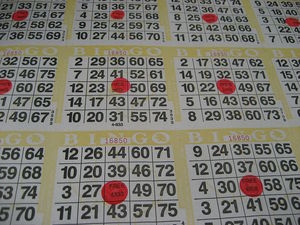The game of bingo sounds simple enough: Match the called numbers to numbers on your own cards, but in more involved games with different designs and patterns, confusion can set in quickly. Before heading to your local bingo halls looking to win money become one step ahead of other bingo players and learn the different bingo patterns that are commonly featured. Understanding these patterns will help you locate numbers faster and prevent missed bingo numbers.
Single Line: Achieve a 5-numbered line either vertically, horizontally, or diagonally. you can use the free space in this game.
Hardway Bingo: Get any 5-numbered line vertically, horizontally, or diagonally without using the free-space.
Double or Triple Bingo: The same as a single-lined bingo, except players must either get two or three bingo lines. There is also double or triple hardway bingo, where two or three lines must be made without the use of the free space. All of the bingos must appear on the same card as well.
Large Diamond: A diamond shaped pattern that uses the top of bottom “N” numbers, middle “B” and “O” numbers and the two numbers surrounding the middle number in both “I” and “G.”
Large Picture Frame: All of the outer edge numbers must be covered. This includes all of the “B” and “O” numbers. The game “Top and Bottom Line” may precede this game.
Small Picture Frame: Cover all the numbers that surrounds the free space. This includes three “I” numbers, three “G” numbers and two “N” numbers. “B” and “O” numbers are not needed for this game.
Letter X: Cover the two diagonals across a card to form the letter “X.” “N” numbers are needed during this game.
Letter L, F, and T: Cover all the spots to make the respective letters. Letter “L” covers the “B” line and bottom line, letter “F” covers the B line, top line and the middle “I” number. Letter “T” covers the “N” line and the whole top line. Letter L and T may be flipped in multiple directions depending on the bingo hall.
Double Cross: Cover all the “N” numbers and the two numbers surrounding the middle number in the “I” and “G” column to create the cross pattern.
Jail Bars: Cover the “B”, “N”, and “O” rows completely to create the jail bar pattern.
Postage Stamp: Cover a section of four numbers on any corner of the card. Most games feature either a double or triple postage stamp pattern where two or three stamps must be made.
Six or Nine Pack: A six pack is a 2×3 collection of numbers anywhere on the card, but the free space cannot be used to form the pattern. The nine pack is a 3×3 collection of numbers in which the free space must be used.
Picnic Table: Cover all the numbers in the letter “X” pattern along with the top line to form the picnic table pattern.
Crazy Kite: Form a postage stamp pattern in any corner and extend the tail of the kite with the two diagonal spots that go along with it.
Indian Star Bingo: Played in most Native American casinos, the Indian Star bingo is the letter X along with the complete “N” line. This is usually one of the final games played at bingo.
Fill The Card: Also referred to as the “Coverall,” fill the card means that every number must be covered to win. This is typically this big prize playing game and ends with around 55 to 60 numbers called.



